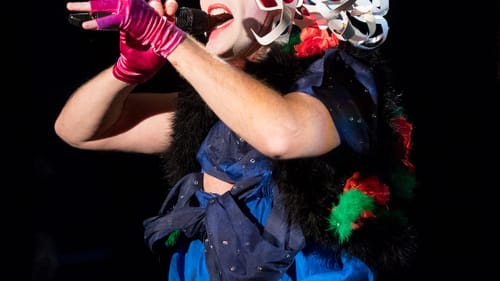Stay in the Loop
BSR publishes on a weekly schedule, with an email newsletter every Wednesday and Thursday morning. There’s no paywall, and subscribing is always free.
A queer 'Gesamtkunstwerk'
PIFA 2018: Taylor Mac's 'A 24-Decade History of Popular Music, Part II, 1896 to Present'

During the final 12 hours of Taylor Mac’s A 24-Decade History of Popular Music, I couldn’t help drawing comparisons to Wagner’s epic Ring cycle. The parallels between Mac’s magnum opus and Wagner’s Gesamtkunstwerk extend beyond mere length — when you consider it, both works explore the construction and dismantling of a system of identity.
Wagner began his tetralogy with the elevation of the gods to their exalted positions (Das Rheingold) and ended with the reign of human beings (Götterdämmerung). Mac began last week with the formation of American identity in 1776 as a series of rigidly defined expectations: white, male, straight, educated, propertied. Two-dozen decades later, judy (Mac's pronoun) showed us how that set of standards has splintered and cracked.
With each passing decade, Mac introduces new identities to U.S. oral history. The concluding eras highlight a slew of voices that were not on the minds of those who endorsed the credo that “all men are created equal.” The project ends with judy alone on stage — a genderqueer entertainer singing self-composed songs of hard-won freedom. It represents the United States many of us want to see, and that many fear is under attack.
A 24-Decade History of Popular Music is a massive, brilliant achievement. But as with the Ring Cycle, it contains more than a few sections that threaten to derail the piece’s forward momentum. Perhaps it reflects my own personal biases — I find the music considered during the earlier decades far more interesting — but the material for several of the contemporary decades seems underdeveloped or confusing.
Special guests
Mac’s examination of speakeasy culture during Prohibition began promisingly, as judy tied that era’s popular culture to the larger consideration of U.S. appropriative habits. As judy remarked that classic flapper dances have much in common with minstrelsy, many in the audience brought their dancing to a halt. That sense of discomfort is warranted, Mac reminded us: “Nothing in America is innocent.”
But the remainder of the decade (1916-1926) went off the rails, with an overextended audience-participation skit involving queer soldiers from World War I, dramatic readings from Ulysses, and beloved Philadelphia drag queen Martha Graham Cracker (Pig Iron Theatre Company co-founder Dito Van Reigersberg) swanning on an inflatable pink flamingo float. Martha offered an overindulgent vamp on Walter Donaldson’s “Love Me or Leave Me.”
Mac then juxtaposed Great Depression’s doldrums with the Harlem Renaissance’s decadence, with great assistance from Detroit-based blues singer Thornetta Davis. Davis performed an entendre-laden original composition, “My Handy Man,” that recalled Alberta Hunter at her most playful.

But judy stopped short of fully investigating these parallel events, leaving many of the Harlem Renaissance’s key figures in the annals. An attempt to coax the audience to “perform poverty” through a mock soup kitchen descended to chaos. For a project that takes race as a central theme, Mac did not seem interested in connecting the Depression-era mindset to our current moment, where “economic anxiety” is often used as a cover for racist ideology.
There were surely other elements that didn’t work at all or didn’t catch fire as Mac intended. Judy’s 1940s hypothesis that white supremacy is created from nostalgia hardly breaks new ground, and a section on the Stonewall Riot seems too ponderous. And sad though it is to say, judy’s original compositions are uniformly weak. The final hour lacks the curatorial skill that makes the rest of the project feel so vital.
Pitch-perfect imperfection
But when the piece works, which is often, it contains the perfect unity of music, message, and performance Wagner strove to deliver in his operas. Mac’s dramatization of white flight — literally having white audience members and people of color cram themselves into discrete sections representing suburbs and city — drives home the fear of the other that still pervades so much of U.S. life. It dovetails beautifully into a riff on gentrification, although Mac implores white audience members not to displace people of color who may be sitting in their original seats.
A symbolic recreation of the March on Washington shows the 1960s musical intersection of rock-n-roll, folk, blues, and spirituals. Mac’s resonant baritone, possessed of a brilliantly haunted quality, does particular justice to Nina Simone’s immortal protest song “Mississippi Goddam.” Though a brilliant musician, Simone famously eschewed correct pitches in her singing; mimicking this style, judy commented, “Inequality is not always on pitch.”
Mac has a preternatural gift for understanding and empathizing with events outside judy’s own experience. This clearly comes through in evocations of Jewish tenement life — we see the bitter irony of Irving Berlin’s ballad “All Alone,” written in a place teeming with people — or the Sleepy Lagoon Murders for which the Chicano community in 1940s Los Angeles was unfairly criminalized.
But Mac comes to full, breathtaking life when reflecting on experiences that affect judy personally: chiefly, the AIDS crisis. Judy’s AIDS decade contains repeated gut punches, from the familiar fear of infection to the sad reality of artists lost in their prime. Mac describes the difficulty in finding three songs about gay life written by gay men in the 1980s: many weren’t writing, because they were dead or dying.
But even within this darkness, Mac movingly recounts judy’s own queer awakening, which occurred at a San Francisco AIDS march just a few hours removed from the conservative California town where judy grew up. “The first time I ever saw an out homosexual, it was thousands at the same time.”
For the first time, Mac saw judyself reflected in the world. And that became judy’s project: to reflect how the boundaries of U.S. life have shifted, widened, and expanded across our 24 decades of history. Given the evidence judy presents, I remain hopeful for the future.
What, When, Where
A 24-Decade History of Popular Music, Part II: 1896-Present. Conceived and co-directed by Taylor Mac, Niegel Smith co-directed. Philadelphia International Festival of the Arts. June 9, 2018, at the Merriam Theater, 250 S. Broad Street, Philadelphia. (215) 893-1999 or pifa.org.
Sign up for our newsletter
All of the week's new articles, all in one place. Sign up for the free weekly BSR newsletters, and don't miss a conversation.

 Cameron Kelsall
Cameron Kelsall